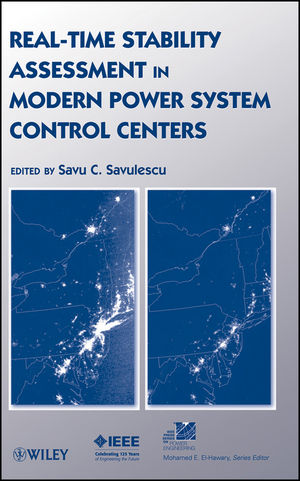Real-Time Stability Assessment in Modern Power System Control CentersISBN: 978-0-470-23330-6
Hardcover
425 pages
February 2009, Wiley-IEEE Press
 This is a Print-on-Demand title. It will be printed specifically to fill your order. Please allow an additional 10-15 days delivery time. The book is not returnable.
|
||||||
Contributors.
1 The Real-Time and Study-Mode Data Environment in Modern SCADA/EMS (Sudhir Virmani and Savu C. Savulescu).
1.1 Introduction.
1.2 SCADA/EMS Architectures.
1.3 Integrating Stability Applications with the SCADA/EMS.
1.4 References.
2 Overview of Key Stability Concepts Applied for Real-Time Operations (Savu C. Savulescu).
2.1 Introduction.
2.2 In Search of the Stability Limits.
2.3 Transient and Voltage Stability Limits.
2.4 Steady-State Stability Limits.
2.5 Concluding Remarks.
2.6 References.
Annex 1-1. Reactive Power Steady-State Stability Criterion dΔQ/dV.
3 LIPA Implementation of Real-Time Stability Monitoring in a CIM Compliant Environment (Loris Arnold, Janos Hajagos, Susan M. Manessis, and Anie Philip).
3.1 Introduction.
3.2 Static and Dynamic Security Assessment at LIPA.
3.3 Benchmarking the Real-Time Stability Application.
3.4 Practical Experience and Outlook.
3.5 References.
4 Real-Time Stability Monitoring at the Independent System Operator in Bosnia and Herzegovina (Dusko Vickovic and Roland Eichler).
4.1 Introduction.
4.2 Interim Implementation of Real-Time Stability Assessment at NOS BiH.
4.3 Real-Time Stability Assessment in the New SCADA/EMS Environment.
4.4 Conclusions and Recommendations.
4.5 References.
Annex 4-1. TSL, TTC, and the Stability Envelope.
Annex 4-2. Siemens Implementation of the Continuation Power Flow.
5 Experience with Real-Time Stability Assessment at Transelectrica (Horia S. Campeanu, Cornel Erbasu, and Cornel Aldea).
5.1 Introduction.
5.2 Security Assessment Philosophy and Criteria.
5.3 Real-Time Steady-State Stability Assessment and Monitoring.
5.4 Off-Line Stability Tools in Support of System Operations.
5.5 Conclusions and Outlook.
5.6 References.
6 Implementation of Online Dynamic Security Assessment at Southern Company (Kip Morison, Lei Wang, Fred Howell, James Viikinsalo, and Alan Martin).
6.1 Introduction.
6.2 DSA Implementation Fundamentals.
6.3 Transient Security Assessment Implementation at Southern Company.
6.4 Conclusions.
6.5 References.
Annex 6-1. Further Details of the DSA Software and Hardware Architecture.
Description of the Core DSA Software.
Online DSA Implementation Using DSATools.
7 Online Security Assessment for the Brazilian System?A Detailed Modeling Approach (Jorge L. Jardim).
7.1 Introduction.
7.2 Security Criteria and Functions.
7.3 Solution Methods and Architecture.
7.4 Practical Implementation Aspects.
7.5 User Interface And Performance.
7.6 Concluding Remarks.
7.7 Acknowledgments.
7.8 References.
8 Dynamic Network Security Analysis in a Load Dispatch Center (Guenther Beissler, Olaf Ruhle, and Roland Eichler).
8.1 Introduction.
8.2 Siemens Approach to Dynamic Security Assessment.
8.3 Case Studies: Challenges, Implementation Approach, and
Solution Features.
8.4 References.
Annex 8-1. Further Dynamic Simulation Capabilities.
Time Frame for Dynamic Simulations.
Simulation in the Frequency Domain.
Eigenvalue and Modal Analysis.
9 Real-Time Transient Security Assessment in Australia at NEMMCO (Stephen J. Boroczky).
9.1 Introduction.
9.2 Transient Security Assessment at NEMMCO.
9.3 Performance and Reliability.
9.4 Experience, Benefits, and Outlook.
9.5 References.
10 Online Voltage Security Assessment in the Hellenic Interconnected System (Costas Vournas, George Christoforidis, and Thierry Van Cutsem).
10.1 Introduction.
10.2 The Control Center of HTSO.
10.3 Online VSA in the Hellenic System.
10.4 Use of Online VSA For Arming Load-Shedding Protection.
10.5 Conclusion.
10.6 References.
Annex 10-1. Quasi-Steady-State Simulation.
Principle of the QSS Approximation.
Handling of Frequency in QSS Simulation.
QSS Model of the Synchronous Machine and its Regulations.
Numerical Integration of the QSS Model.
11 The Real-Time Supervision of Transmission Capacity in the Swedish Grid (Lars Sandberg and Klas Roudén).
11.1 Introduction.
11.2 Prior and Current Application Development at SVK.
11.3 Voltage Security Assessment with SPICA.
11.4 Benefiting from the Knowledge of the Current Transmission Capacity.
11.5 Additional SPICA Functionality.
11.6 Summary.
Appendix A Dimo?s Approach to Steady-State Stability Assessment: Methodology Overview, Numerical Example, and Algorithm Validation (Roberto D. Molina Mylius, Martín Cassano, and Savu C. Savulescu).
A.1 Methodology Overview.
A.2 Numerical Example?Independent Testing of Algorithm Implementation.
A.3 Benchmarking the Methodology.
A.4 Conclusions.
A.5 References.
Appendix B SIME: A Comprehensive Approach to Transient Stability (Mania Pavella, Daniel Ruiz-Vega, and Mevludin Glavic).
B.1 Introduction.
B.2 Basic Formulation.
B.3 Preventive SIME.
B.4 Emergency SIME.
B.5 Postface.
B.6 References.
Notation.
Abbreviations and Acronyms.
Appendix C Detection and Evaluation of Stability Constrained (Marius Pomarleanu and Savu C. Savulescu).
C.1 Introduction.
C.2 Approach.
C.3 Conclusions.
C.4 References.
Index.



